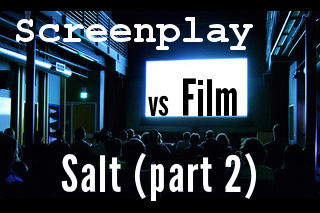Yesterday, I kicked off my Screenplay vs Film series by describing screenwriting tips learned by comparing the screenplay and film versions of the summer blockbuster Salt, in which a CIA agent (Angelina Jolie) goes on the run when a defector accuses her of being a Russian spy. If you missed it, click here for the first half of 11 Screenwriting Tips from Salt.
I actually learned a lot of screenwriting tips by comparing the two, so I had to break the post into two parts. Here is the 2nd part.
Screenwriting Tip #6: Think twice about your hero’s introduction
In the best intro scenes, we learn several things about the movie’s hero all at once. In Salt’s screenplay, we meet Salt for the first time as he’s doing some hardcore butt-kicking. Not.
We meet him arguing with his boss, Winter, over which cell phone provider is better. It makes them come across as overpaid, underworked bureaucrats with the intellectual curiosity of two tweens who text each other about Taylor Lautner’s dating habits.
The movie starts with Evelyn Salt being tortured by North Koreans. Throughout the ordeal, she repeats “I’m not a spy. I’m not who you think I am.” A minute later, we learn that she IS a spy and that her boyfriend was instrumental in her release. In that moment, we realize how deep her mental strength is. We also have an emotional connection to her because of her ordeal. Finally, we learn how close Salt is with her soon-to-be husband, which is the cornerstone of the movie’s emotional heart.
This intro was great because it accomplishes so much. For another screenplay intro that covers a lot of ground, read screenwriting tip #1 in 12 Screenwriting Tips from Back to the Future. You might also be interested in this article about screenplay hero introductions.
Back to Salt…the interesting thing is that this scene was in Wimmer’s original screenplay — but it occurred much later, a little after the midpoint. Speaking of midpoints…
Screenwriting Tip #7: Midpoints are tricky…
Midpoints are one of the 8 essential plot points in a script outline because they can resuscitate a dragging second act. The most effective midpoints function as fulcrums which change the direction of the screenplay in some way.
In the movie version of Salt, Evelyn Salt achieves one major goal: killing the Russian president. The second half of the story is driven by her new goal: to take over America’s nuclear arsenal. Additionally, at the midpoint, we see that she had a chance to shoot at one of her pursuers, but she didn’t take it. So you can argue that at the midpoint, the audience also knows that Salt isn’t the Russian spy that the CIA believes her to be.
In the screenplay version of Salt, Salt kills a team of Russians in pursuit of that bloody piece of paper, KA-88. After that, we flashback to his wedding. It’s a nice, well-described scene, but the movie’s midpoint is more effective because we have a clearer understanding of Salt’s goals.
Screenwriting Tip #8: Your description should be in keeping with your story’s world
In Wimmer’s screenplay, there’s a wonderful comparison:
And cripplingly defeats them all – delivering the coup de gras [sic] to the Russian powerlifter, breaking him down as though he were no more than a Urals spring mountain-flower.
This is fantastic description. It gives us a clear, vivid image and it does so using imagery strongly associated with Russia. This makes the world of Salt, in which a Russian spy program plays a key part, more real. Remember this when you’re writing your movie and are striving to avoid cliched comparisons.
Screenwriting Tip #9: Use conflict to hide clues
In the movie, Salt is married to a renowned arachnologist. In the very beginning, Salt tells him affectionately to “put away his bugs.” “They’re spiders,” he replies. “Bugs.” “Spiders.” Back and forth they argue.
Not only do we see Salt’s domestic bliss, which sets up the emotional heart of the movie and a key subplot, but it also introduces the importance of the spiders without being obvious.
Later, when we learn that Salt didn’t kill the Russian premier, but temporarily paralyzed him with spider venom, it doesn’t come out of the blue. At the same time, it’s still a plot twist. Keep this in mind when you need to introduce your audience to information that you want them to absorb without drawing too much attention to it. Here are more examples of artfully done setups and payoffs, this time from the teen comedy Mean Girls, written by Tina Fey.
Screenwriting Tip #10: Up the stakes
In Wimmer’s screenplay, once Salt was accused of being a Russian spy, he avowed several times that before the CIA would catch him he would hold his wife and daughter one more time. At the same time, it also appeared like he was going to assassinate the president-elect of the United States.
In the movie, Evelyn Salt’s husband is murdered in front of her at the midpoint, so holding him one more time can’t be her goal for the second half.
Instead, her goal is to takeover America’s nuclear arsenal, which is a very high-stake and urgent goal. It seemed like the kind of goal that’s more suitable for a high-octane, mega-budget thriller.
Screenwriting Tip #11: Maximize conflict with the minimum number of characters
In Salt’s screenplay, there were a lot of minor characters. Winter, Salt’s boss, had a boss. Winter had a henchmen named Peabody. He also had nerdy underlings whose names I don’t remember. Also, there were a bunch of Russians in search of Salt and KA-88.
In the movie, all of these characters get boiled down to three: Salt, Winter & Peabody (who’s now a counter-intelligence agent). Despite the decrease in characters, the conflict didn’t diminish. It just became triangulated between these three characters. When Winter and Peabody aren’t arguing about how to handle Salt, they’re chasing her down. This kept the conflict and action high while keeping the confusion low.
If you have a draft of a screenplay in front of you, examine your list of characters and ask yourself if all of them are necessary. See how many you can eliminate without eliminating the conflict.
In Salt, Winter was countered by Peabody, who professionally, played a regulatory role. This was also a smart move because it didn’t follow the standard boss-employee relationship. Winter’s power matched Peabody’s. Can you do the same in your screenplay? If you’d like another example of how it can be done, read the “Screenplay Spanx & Obvious Exposition” section of Selling Your Screenplay Requires Some Spanx.
Final thoughts
I hope that everyone who wants to write for the movies found these screenwriting tips useful! Comparing the theatrical version of Salt with one of its screenplay drafts yielded a lot of them, so it was a great movie & screenplay to kick off our series.
But we’re not yet done with Salt…tomorrow, I’ll post a a list of Salt’s plot points. If you write down each plot point onto an index card and divide them into columns so that the last card in every column is either a major turning point or an Act break, you will improve your understanding of story pacing and screenwriting structure. Do this often enough and plotting your screenplay will become second nature as your pursue your dream to write for the movies.
Watching a blank screen (with modifications) by Kenneth Lu





















Comments on this entry are closed.
Many thanks for this, I know that Salt is a little old now, but I really liked how you pointed out how her love for her husband drove her and the B story and ultimately became a catalyst for her change. It wasn’t just an action film, it had heart as you mentioned.
Thanks again
Jon